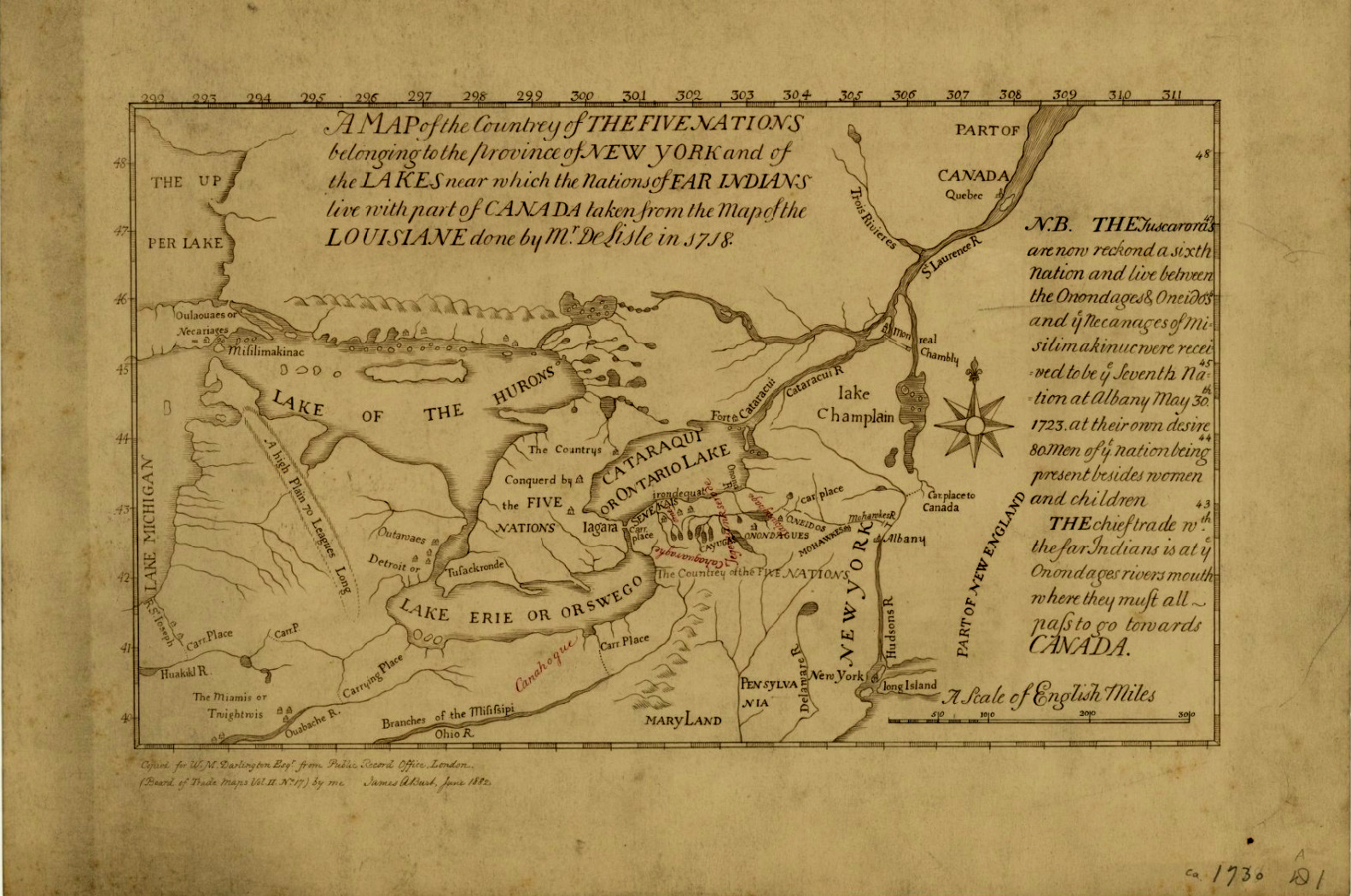Long before Europeans came to North America, a thriving democratic system was established in the heart of what would become New York State. The Haudenosaunee Confederacy, known to the French colonists as the Iroquois League and the English colonists as the League of Five Nations (later, Six Nations), was already well-established, united in a confederation of nations governed by their Great Law of Peace. As we enter Native American Heritage Month, the Historical Society of the New York Courts would like to honor the Haudenosaunee’s deep contributions to the development of our own democracy, here in New York State and the United States overall with just a peek into the story of how the Haudenosaunee’s governance principles played a pivotal role in shaping New York’s government and laying the foundation for American democracy.
The Haudenosaunee Confederacy
The Haudenosaunee, composed of the Mohawk, Oneida, Onondaga, Cayuga, and Seneca nations, with the later inclusion of the Tuscarora, were the original inhabitants of the land that is now New York State, as well as parts of contemporary Canada. They established a system of governance known as the Great Law of Peace, which dates to the 12th or 13th century. This system embodied principles that resonated with the very core of democracy. The Great Law of Peace is said to have been brought to the nations by the Great Peacemaker, who helped the previously conflicting nations to come together in a confederacy on the shores of Onondaga Lake near today’s Syracuse.
A Council of Nations
At the heart of the Haudenosaunee system was the “Great Council,” a council composed of representatives from each member nation. While it might not have been a direct antecedent of today’s Congress, it shared the fundamental principle of representative democracy. These representatives, or sachems, deliberated and made decisions by striving for consensus, a concept that is a cornerstone of American democracy. Consensus decision-making, the process where all parties involved must agree on major decisions, was central to the Haudenosaunee’s governance. They understood that fostering unity and ensuring that every voice was heard was essential. This emphasis on consensus echoes in the American political system where the framers of the U.S. Constitution aimed to reach agreements and compromise among diverse interests.
Decision-Making by Consensus
The Haudenosaunee’s unique clan system also played a significant role in their governance. Their society was organized into clans, each associated with a different animal or symbol. These clans are matrilineal, meaning descent and membership were traced through the mother’s line. The clan system influenced leadership selection and maintained social order, an early form of checks and balances that we find in the American political structure.
The Great Law of Peace was not simply a theoretical concept; it was symbolically recorded and transmitted through wampum belts. These meticulously crafted beadwork belts conveyed messages, agreements, and the history of the Haudenosaunee. This reliance on symbolism and oral tradition resonates with the early history of the United States when foundational documents like the Declaration of Independence and the U.S. Constitution were read aloud and discussed in public forums, emphasizing the importance of shared values and symbols.
Another enduring symbol of Haudenosaunee culture is the “Tree of Peace,” typically represented by a white pine tree. This symbolized the end of wars and the establishment of peace among the member nations. It illustrates a strong commitment to peaceful coexistence, a value that also found its way into the American ethos.
Influence on Early Leaders
Several of the American Founding Fathers, such as Benjamin Franklin and Thomas Jefferson, had direct interactions with the Haudenosaunee and were exposed to their political and social systems. These encounters likely influenced their political thinking and played a role in shaping the emerging United States’ governance and democratic principles.
In essence, the Haudenosaunee’s Great Law of Peace served as an early example of democratic principles in practice, for New Yorkers and their fellow Americans. Their emphasis on consensus decision-making, representation, individual rights, and a commitment to peace had a profound impact on the development of New York’s government and the broader project of American democracy.
As we observe Native American Heritage Month, let us not forget the enduring legacy of the Haudenosaunee and their contributions to shaping the democratic ideals that are at the very heart of our nation. This month, and beyond, we honor the rich tapestry of indigenous cultures and their vital role in shaping the land we now call home. You can learn more about the legal relationship between New York State and tribal nations, including the member nations of the Haudenosaunee, in volume 14 of the Society’s signature publication, Judicial Notice. After you read Judicial Notice, we encourage you to learn more about the Haudenosaunee and their rich legacy by exploring the Haudenosaunee Confederacy’s website, visiting the Skä•noñh Great Law of Peace Center at Onondaga Lake and reading this brief introduction for educators provided by the Smithsonian’s National Museum of the American Indian.

